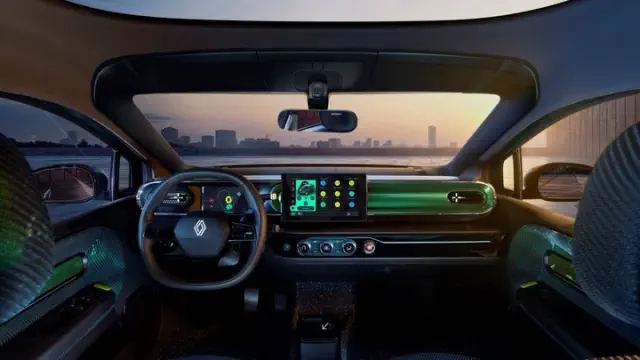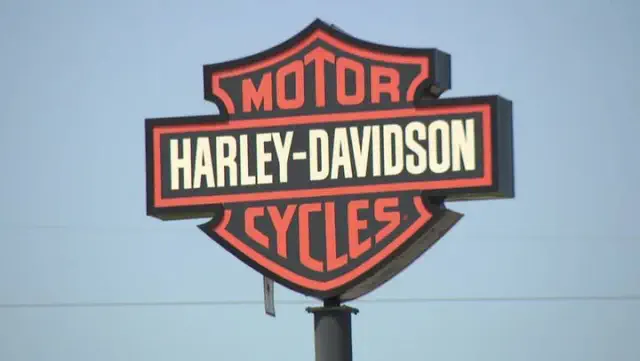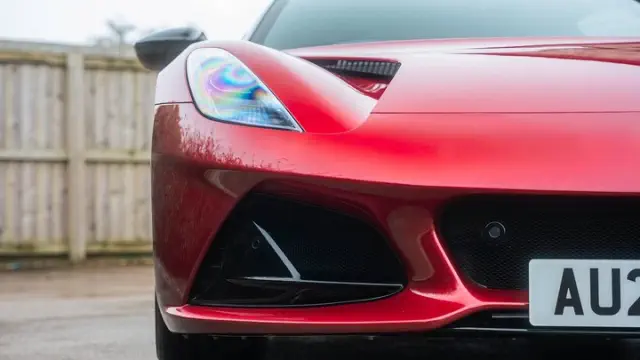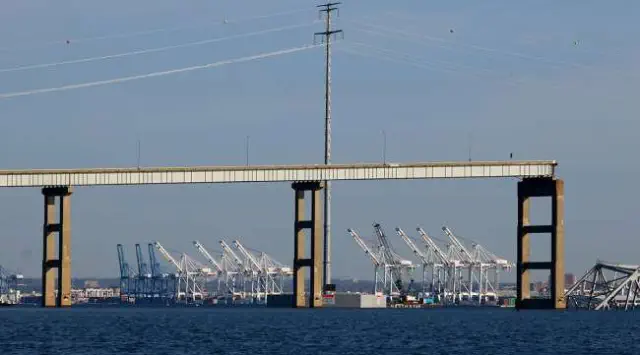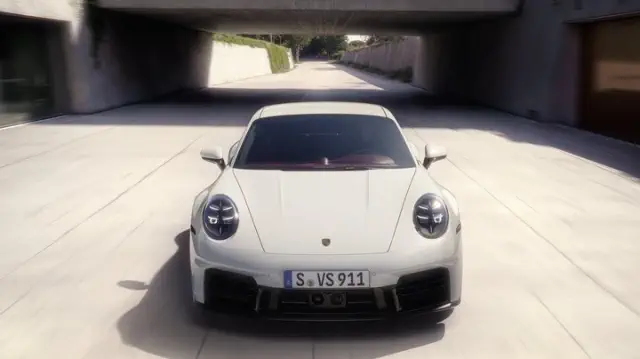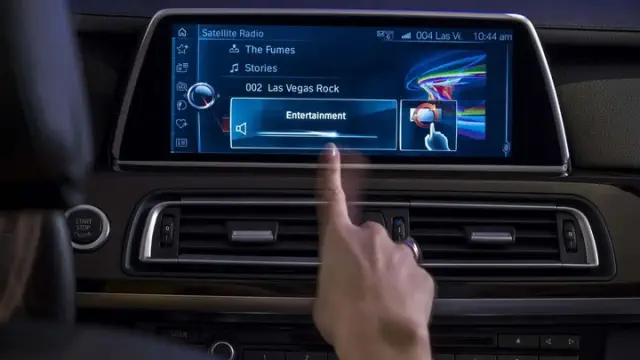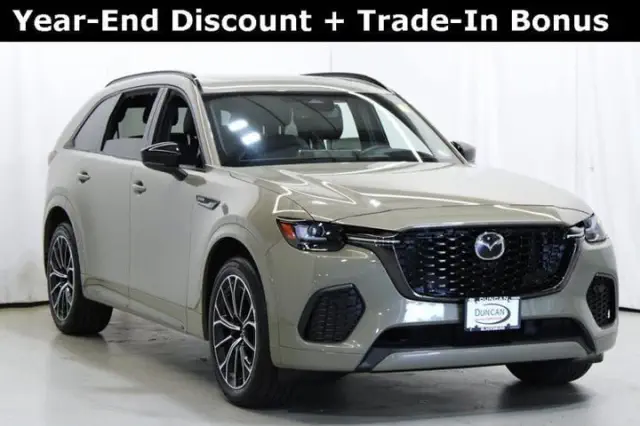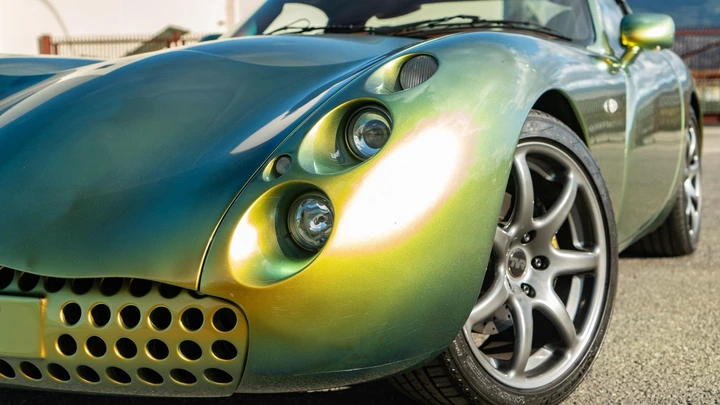
View pictures in App save up to 80% data.
While measuring speed and acceleration is an empirical, objective pursuit, experiencing it is somewhat more subjective. The Bugatti Veyron was one of the first explosively fast cars that isolated the driver from the sensation of speed. EVs took it to the next level. Aside from the lung-crushing G-forces, you may as well be traveling by bullet train. Drive the new BMW M5 and tell us it's an engaging experience; it's not.
At the other end of the scale are cars like the Ferrari F40 and just about every TVR ever made. If the sheer visceral feel of speed is what excites you, then you may be pleased to hear that the mental TVR Tuscan Speed Six now falls under the US 25-year import rule. That means you can finally test your heart’s max BPM on the way to the shops each day and then down an espresso just to calm down.
If this represents your vision of a sports car experience, allow us to share some insights about one of the most ferocious sports cars ever created.
First introduced in 1999, certain early models became technically eligible for import as of last year. However, with the arrival of 2025, a wider selection of Tuscan Speed Six sports cars can now be imported. It's important to note that the 25-year import rule pertains to the specific manufacture date of each vehicle, rather than the overall production period of the model line.
TVR - The Genesis Tale
TVR's origins date back to 1946, when Trevor Wilkinson founded a modest engineering company known as Trevcar Motors. Shortly thereafter, the name evolved into TVR Engineering, and the company began to introduce a gradual yet consistent lineup of TVR vehicles. Like many small independent car manufacturers, TVR faced numerous challenges, including financial difficulties, acquisitions, and production hurdles. Nevertheless, each vehicle continued to embody the foundational idea of a lightweight tubular chassis paired with a front-engine, rear-drive configuration.

View pictures in App save up to 80% data.
Include CarBuzz in your Google News updates.
When Peter Wheeler saved the company from financial distress in 1981, he revitalized the brand and introduced some of its most iconic models. Cars like the Griffith, Chimaera, and Cerbera were all giant-killing sports cars, capable of challenging the fastest Porsches and Ferraris at a fraction of the cost. Build quality and reliability weren’t always a strong point, but every TVR made up for it with buckets of character and a soulful driving experience. The last cars rolled off the production line in 2006, but there have been attempts to reboot the brand in recent years.
With the history lesson concluded, let’s shift our focus to the newest TVR from this era that is now ready to be brought to our shores.
The TVR Tuscan Speed Six: A Featherweight Beast
The TVR Tuscan Speed Six was introduced in 1999 to join the aging Rover V8-powered Griffith and Chimaera. It was the third time that the Tuscan name had been used on a TVR, but this one bore the swoopy styling and futuristic interior design that marked this era of TVR apart from just about anything else on the road. Whereas major manufacturers had long adopted ABS and traction control to tame their sportier offerings, the Tuscan Speed Six made do with just power-steering to separate the driver from the true, raw character of the car.
For years, TVR had incorporated Rover's well-known V8 engine into a variety of its models. However, when the Tuscan was introduced, the company unveiled its own 3.6-liter straight-six engine, which boasted significantly more power and an impressive sound, even when idling. While it shared its inline-six configuration with a BMW, the experience was quite different; whereas even a high-performance M car would produce a smooth, turbine-like sound up to its redline, the TVR Speed Six engine roared like a caged race engine, unleashing a ferocious growl that hinted at its raw power.
Engine |
3.6-4.0-liter inline-six |
|---|---|
Power |
350-400 bhp |
Torque |
290-315 lb-ft |
Curb Weight |
2,420 lbs (est.) |
0-60mph |
3.9 seconds claimed |
Top Speed |
165-180 mph+ |
The first Tuscan released in 1999 had 360 horsepower and a curb weight of just 2,420 lbs. That gave it a power-to-weight ratio way better than a contemporary Porsche 911 Carrera or even a Ferrari F355. A five-speed manual transmission and rear-wheel drive were standard on all models.
The straight-line acceleration of the Tuscan was astonishing, effortlessly outpacing vehicles that were priced at double its cost. However, it wasn't without its flaws. The absence of traction control and ABS meant that only experienced drivers could truly tap into the car's capabilities. Moreover, the early models were known to be challenging to handle at their limits, with contemporary reviewers suggesting that the suspension required further refinement. When approached with the caution it required, the Tuscan offered an exhilarating driving experience, guaranteed to bring joy even at moderate speeds.
A Comprehensive Look at the Tuscan Speed Six
Although the Tuscan couldn't rival the build quality and refinement of a BMW M3 or Porsche 911, it certainly held its own in terms of performance, which is where the initial upgrades were concentrated. Shortly after the Tuscan entered production, the Red Rose performance pack was introduced. This package featured upgraded brakes and suspension parts, distinctive 18-inch wheels, and enhancements to the engine that boosted its output by an extra 40 bhp.
The Tuscan S made its debut a few years later, featuring a 4.0-liter variant of the Speed Six engine that delivered a robust 400 hp. In 2005, the Tuscan Mk2 was launched during the last production year, showcasing several cosmetic enhancements along with mechanical improvements. The front end became more stable due to the introduction of a new steering rack, larger brake calipers, and modified suspension mounting points.
The outcome was a somewhat more subdued driving experience, yet it remained significantly more responsive and thrilling than nearly any other vehicle available on the roads during that period.
The Competitors of Tuscany
The Tuscan was manufactured from 1999 to 2006, with its initial models debuting in 2000. Competing vehicles included the BMW Z3 M Coupe, known for its exhilarating driving experience, and the Porsche Boxster S, which excelled in handling precision and stability. In the year 2000, the Tuscan was priced at 40,000 GBP, approximately $50,000, making it a more affordable option compared to both the BMW and Porsche by a notable difference.
When it comes to value for money, the Tuscan stands out significantly. While the Germans excelled in terms of handling and overall refinement, the driving experience is what modern classic car enthusiasts truly desire. For those wanting to feel the essence of a genuine analog sports car, the TVR Tuscan delivers an exhilarating rush of automotive excitement. In recent years, prices have consistently climbed at European auction houses and classic car dealerships, although there's a noticeable disparity between pristine, show-quality vehicles and those that have seen considerable use. A reasonable starting price for a decent Tuscan is around $35,000, while top-notch models can fetch as much as $140,000. The ideal price point lies somewhere in between these figures, and although maintenance and parts may not come cheap, the limited production of just 1,677 units suggests that values will continue to appreciate.
Make sure to purchase a vehicle that was manufactured at least 25 years ago, as the 25-year import rule is based on the production date of the car. Attempting to bring in one of the more recent models is likely to result in it being sent to the junkyard.
